

Designation:Geneva class Super Dimensional Guided Missile Cruiser (SCG)
|
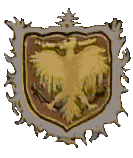
|
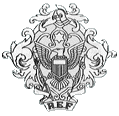
|
|||
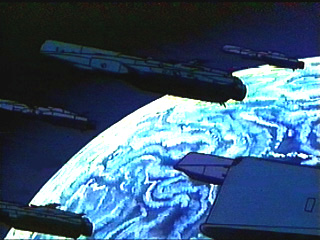
|
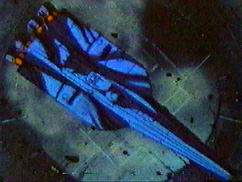
|
||||
| Hull | Name | Fleet | Commissioned | Fate |
|---|---|---|---|---|
| SCG-01 | Geneva | EF | 2012 | Destroyed 2013 |
| SCG-02 | London | EF | 2013 | Destroyed 2013 |
| SCG-03 | Paris | EF | 2013 | Destroyed 2017 |
| SCG-04 | Washington | ASC | 2014 | Destroyed 2030 |
| SCG-05 | Beijing | EF | 2014 | Destroyed 2020 |
| SCG-06 | Berlin | ASC | 2015 | Destroyed 2030 |
| SCG-07 | Tokyo | ASC | 2015 | Destroyed 2030 |
| Hull | Name | Fleet | Commissioned | Fate |
|---|---|---|---|---|
| SCA-21 | Ardennes | EF | 2016 | Destroyed 2030 |
| SCA-22 | Midway | ASC | 2016 | Destroyed 2030 |
| SCA-23 | Austerlitz | EF | 2016 | Destroyed 2030 |
| SCA-24 | Cannae | EF | 2016 | Destroyed 2043 |
| SCA-25 | Tarawa | EF | 2016 | Destroyed 2025 |
| SCA-26 | Dieppe | EF | 2016 | Destroyed 2028 |
| SCA-27 | Coronel | ASC | 2016 | Destroyed 2030 |
| SCA-28 | River Plate | ASC | 2016 | Destroyed 2030 |
| SCA-29 | Alamein | ASC | 2017 | Destroyed 2030 |
| SCA-30 | Java Sea | EF | 2017 | Destroyed 2020 |
| SCA-31 | Tsushima | ASC | 2017 | Destroyed 2030 |
| SCA-32 | Matapan | EF | 2017 | Destroyed 2023 |
| SCA-33 | Kursk | EF | 2017 | Destroyed 2028 |
| SCA-34 | Dien Bien Phu | EF | 2017 | Destroyed 2043 |
| SCA-35 | Taranto | EF | 2017 | Destroyed 2023 |
| SCA-36 | Lexington | ASC | 2017 | Destroyed 2030 |
| SCA-37 | Waterloo | ASC | 2018 | Destroyed 2031 |
| SCA-38 | Falklands | ASC | 2018 | Destroyed 2030 |
| SCA-39 | Leyte Gulf | EF | 2018 | Destroyed 2022 |
| SCA-40 | Nieuwpoort | EF | 2018 | In reserve |
| SCA-41 | Coral Sea | EF | 2018 | Destroyed 2043 |
| SCA-42 | San Jacinto | ASC | 2018 | Destroyed 2030 |
| SCA-43 | Verdun | ASC | 2018 | Destroyed 2030 |
| SCA-44 | Ayn Alut | ASC | 2018 | Destroyed 2030 |
| SCA-45 | Sedan | ASC | 2019 | Destroyed 2031 |
| SCA-46 | Stalingrad | EF | 2019 | Destroyed 2031 |
| SCA-47 | Malta | EF | 2019 | Destroyed 2029 |
| SCA-48 | Crete | EF | 2019 | Destroyed 2030 |
| SCA-49 | Pearl Harbor | ASC | 2019 | Destroyed 2030 |
| SCA-50 | Britain | ASC | 2019 | Destroyed 2030 |
| SCA-51 | Inchon | EF | 2019 | Destroyed 2024 |
| SCA-52 | Salamis | ASC | 2019 | Destroyed 2031 |
| SCA-53 | Thermopylae | EF | 2020 | Destroyed 2031 |
| SCA-54 | Denmark Strait | EF | 2020 | In service as trials vessel |
| SCA-55 | Jericho | EF | 2020 | Destroyed 2028 |
| SCX-56 | Monte Cassino | ASC | 2020 | Destroyed 2031 |
| SCA-57 | Crimea | ASC | 2020 | Destroyed 2030 |
| SCA-58 | Aboekir | EF | 2020 | Destroyed 2031 |
| SCA-59 | Lissa | EF | 2020 | Destroyed 2043 |
| SCA-60 | Little Big Horn | ASC | 2020 | Destroyed 2030 |
| SCA-61 | North Cape | EF | 2021 | Destroyed 2029 |
| SCA-62 | Narvik | EF | 2021 | Destroyed 2030 |
| SCA-63 | Trafalgar | ASC | 2021 | Destroyed 2030 |
| SCA-64 | Tobruk | ASC | 2021 | Destroyed 2030 |
| SCA-65 | Skamander Plain | EF | 2021 | Destroyed 2030 |
| SCA-66 | Yorktown | EF | 2021 | Destroyed 2027 |
| SCA-67 | Iwo Jima | ASC | 2021 | Destroyed 2030 |
| SCA-68 | Vicksburg | ASC | 2021 | Scrapped 2031 |
| SCA-69 | Yom Kippur | ASC | 2022 | Destroyed 2043 |
| SCA-70 | Macross Island | ASC | 2022 | Destroyed 2030 |
| SCA-71 | Wake | ASC | 2022 | Destroyed 2030 |
| SCA-72 | Marne | EF | 2022 | Destroyed 2043 |
| SCA-73 | Alamo | ASC | 2022 | Destroyed 2030 |
| SCA-74 | Saturn's Rings | EF | 2022 | Destroyed 2031 |
| SCA-75 | Tannenberg | EF | 2022 | Destroyed 2026 |
| SCA-76 | Agincourt | ASC | 2022 | Destroyed 2030 |
| SCA-77 | Lepanto | EF | 2023 | Destroyed 2030 |
| SCA-78 | Hastings | ASC | 2023 | Destroyed 2030 |
| SCA-79 | Alesia | EF | 2023 | Destroyed 2029 |
| SCA-80 | Guadalcanal | ASC | 2023 | Destroyed 2043 |
| SCA-81 | Yper | ASC | 2023 | Scrapped 2031 |
| SCA-82 | Bataan | ASC | 2023 | Destroyed 2030 |
| SCA-83 | St. Vincent | ASC | 2023 | Destroyed 2043 |
| SCA-84 | Bandung Strait | ASC | 2024 | Destroyed 2031 |
| SCA-85 | Dunkirk | ASC | 2024 | Destroyed 2030 |
| SCA-86 | New Orleans | ASC | 2024 | Destroyed 2030 |
| SCA-87 | Corregidor | ASC | 2024 | Destroyed 2030 |
| SCA-88 | Warsaw | ASC | 2024 | Destroyed 2030 |
| SCA-89 | Sarajevo | ASC | 2024 | Destroyed 2030 |
| SCA-90 | Omdoerman | ASC | 2024 | Destroyed 2031 |
| SCA-91 | Okinawa | ASC | 2025 | Destroyed 2030 |
| SCA-92 | Base Sara | ASC | 2025 | Scrapped 2030 |
| SCA-93 | Chosin | ASC | 2025 | Destroyed 2031 |
| SCA-94 | Princeton | ASC | 2025 | Destroyed 2030 |
| SCA-95 | Camperdown | ASC | 2025 | Destroyed 2031 |
| SCA-96 | Gallipoli | ASC | 2025 | Destroyed 2030 |
| SCA-97 | Bull Run | ASC | 2025 | Destroyed 2030 |
| SCA-98 | Moscow | ASC | 2026 | Destroyed 2031 |
| SCA-99 | Gaugamela | ASC | 2026 | Destroyed 2030 |
| SCA-100 | Kasserine | ASC | 2026 | Scrapped 2031 |
| SCA-101 | Armada | ASC | 2026 | Destroyed 2031 |
| SCA-102 | Atlantic | ASC | 2026 | Destroyed 2030 |
| SCA-103 | Berlin | ASC | 2026 | Destroyed 2043 |
| SCA-104 | Oran | ASC | 2026 | Destroyed 2031 |
| SCA-105 | Copenhagen | ASC | 2026 | Destroyed 2030 |
| SCA-106 | Kuwait | ASC | 2027 | Destroyed 2030 |
| SCA-107 | Marianas | ASC | 2027 | Destroyed 2030 |
| SCA-108 | Vella Gulf | ASC | 2027 | In reserve |
| SCA-109 | Borodino | ASC | 2027 | Destroyed 2030 |
| SCA-110 | Savo Island | ASC | 2027 | Destroyed 2030 |
| SCA-111 | Tet | ASC | 2028 | Destroyed 2031 |
| SCA-112 | Arnhem | ASC | 2028 | Scrapped 2030 |
| SCA-113 | Quiberon Bay | ASC | 2028 | Destroyed 2031 |
| SCA-114 | Navarino | ASC | 2028 | Destroyed 2030 |
| SCA-115 | Tassafaronga | ASC | 2028 | Destroyed 2030 |
| SCA-116 | Santa Cruz | ASC | 2029 | Destroyed 2031 |
| SCA-117 | Normandie | ASC | 2029 | Destroyed 2030 |
| SCA-118 | Passchendaele | ASC | 2029 | Destroyed 2030 |
| Hull | Name | Fleet | Commissioned | Fate |
|---|---|---|---|---|
| SBC-01 | Defender | ASC | 2026 | Destroyed 2030 |
| SBC-02 | Protector | ASC | 2027 | Destroyed 2030 |
| SBC-03 | Guardian | ASC | 2027 | Destroyed 2030 |
| SBC-04 | Watchman | ASC | 2027 | Destroyed 2030 |
| SBC-05 | Vigilante | ASC | 2027 | Destroyed 2030 |
| SBC-06 | Sentinel | ASC | 2028 | Destroyed 2030 |
| SBC-07 | Angel | ASC | 2028 | Destroyed 2030 |
| SBC-08 | Marshall | ASC | 2028 | Destroyed 2030 |
| SBC-09 | Shieldman | ASC | 2028 | Destroyed 2030 |
| SBC-10 | Townsaver | ASC | 2029 | Destroyed 2030 |
| SBC-11 | Champion | ASC | 2029 | Destroyed 2030 |
| SBC-12 | Nightwatch | ASC | 2029 | Destroyed 2030 |
These ships were built at Moonbase Luna and entered service from 2013 through 2029. Their names are written with the 'UES' prefix.
| ASC | Armies of the Southern Cross |
| EF | Expeditionary Force |
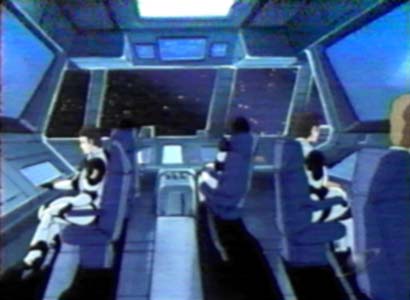
| Geneva | Battle | Defender | ||
|---|---|---|---|---|
| 325 | 287 | 340 | ||
| 225 | 210 | - | ||
| 230 | 230 | - | ||
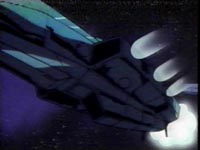
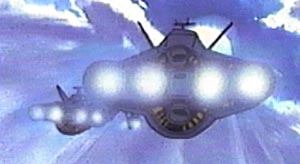
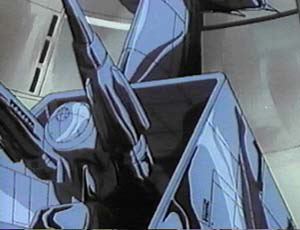
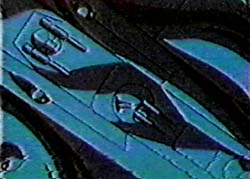

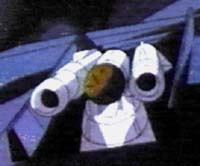 designed to deliver heavy firepower on very close targets. A double barrelled rail gun with a round sensor between the barrels, the RG-2 is stored inside the hull, but elevates upwards from under movable panels into firing position. The RG-2 fires 0.227 kg KPI rounds at 25 kps, giving the rounds a kinetic impact energy of 141 MJ. Maximum effective range for this system is 20 km against mecha sized targets, maximum rate of fire is 120 rounds per minute.
designed to deliver heavy firepower on very close targets. A double barrelled rail gun with a round sensor between the barrels, the RG-2 is stored inside the hull, but elevates upwards from under movable panels into firing position. The RG-2 fires 0.227 kg KPI rounds at 25 kps, giving the rounds a kinetic impact energy of 141 MJ. Maximum effective range for this system is 20 km against mecha sized targets, maximum rate of fire is 120 rounds per minute.
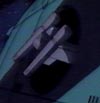
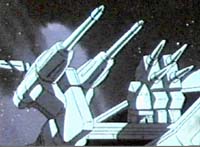
 medium calibre particle beam cannon in a low lying round turret. The cannon can fire 400 MJ of particle energy per second as short duration beams or as enclosed particle packets ('disks') with an effective range of 100,000 km. This cannon is not quite capable enough to be effective against larger ships than Tou Redirs, Re-entry pods, Assault Carriers or Mollusk carriers. The PB-4b is an improved version with a protruding muzzle and greater reliability.
medium calibre particle beam cannon in a low lying round turret. The cannon can fire 400 MJ of particle energy per second as short duration beams or as enclosed particle packets ('disks') with an effective range of 100,000 km. This cannon is not quite capable enough to be effective against larger ships than Tou Redirs, Re-entry pods, Assault Carriers or Mollusk carriers. The PB-4b is an improved version with a protruding muzzle and greater reliability.
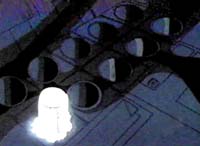
 designed to deliver heavy firepower on very close targets. A double barrelled rail gun with a round sensor between the barrels, the RG-2 is stored inside the hull, but elevates upwards from under movable panels into firing position. The RG-2 fires 0.227 kg KPI rounds at 25 kps, giving the rounds a kinetic impact energy of 141 MJ. Maximum effective range for this system is 20 km against mecha sized targets, maximum rate of fire is 120 rounds per minute.
designed to deliver heavy firepower on very close targets. A double barrelled rail gun with a round sensor between the barrels, the RG-2 is stored inside the hull, but elevates upwards from under movable panels into firing position. The RG-2 fires 0.227 kg KPI rounds at 25 kps, giving the rounds a kinetic impact energy of 141 MJ. Maximum effective range for this system is 20 km against mecha sized targets, maximum rate of fire is 120 rounds per minute.

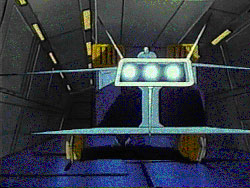
Note: The Battle can accomodate 36 additional fighters by using the launch bays as additional hangars, with the mecha tied down for storage rather than in stalls. However, this was universally unpopular with the pilots as recovery of the additional fighters was not possible, unless a loss rate of 33% was exceeded. Adverse effects on morale lead to the effective abolishment of the practice.
The ASC in the Second Robotech War used Veritech Hovertanks when other, more space-oriented mecha were in short supply. The EF occasionally replaced some fighter squadrons with Destroid squadrons for insertion onto enemy planets.
The Southern Cross replaced one squadron of mecha with a combined squadron of Gossamer shuttles and Bumblebee scouts if a vessel was sent on deep space patrol or exploration missions.
The Geneva class was the first Earth built capital ship capable of fold travel, and although only seven were built, the derivative (some might say sister) Battle class was the backbone of the SC Aerospace Forces, and was an important class for the Expeditionary Forces as well. Its design is very much like that of the Banshee, only larger in all respects. For instance, the side sponsons house two engines each, as well as the two double fighter bays and the a launch pad. The hull has one launch/recovery shute for mecha, halfway down the hull, serving another double hangar. These bays can hold 4 squadrons for 48 mecha total with room for a few other craft in the EF vessels, or, due to the smaller size of their fighters, 6 squadrons for a total of 72 mecha in some SC configurations. The bridge is located in a spade-shaped deck atop a low tower on the upper main hull. The vessel can hold several Special Forces squads, and these ships often held such forces during the recon operations immediately prior to the departure of the final EF deployments.
The Geneva class hulls and flight systems were finished before any comparable Terran designed energy weapon system could be installed, and thus the class received scavenged Zentraedi energy weapons and left over anti-mecha laser cannons from the Oberth and ARMD classes. This configuration survived until 2023 when the surviving members were upgraded to the new Southern Cross standard configuration, and the ships became identical to the SCA-80 and later vessels.
The increased cannon armament of the Battle class, reason for the classification to Heavy Cruiser in contrast with the Geneva classes' Missile Cruiser designation, was small in number but of sufficient firepower for the intended tasks: to provide additional anti-ship firing power to aid the larger capital ships and to perform small actions as the flagship of a detached light force. The RG-60 rail cannon was devastating in its effect and damage concentration; however, the mount could only fire two slugs per ten seconds, precluding large firing patterns. The Southern Cross later ordered yet another upgraded version with a different armament suite; in these vessels (SCA-80 onwards) the upper laser turret and rail gun were replaced with two heavy particle beam weapons, as previously mounted in the Argonaut and Tristar class. This change caused a marked increase in long range firepower. However, older ships were not upgraded to this new standard.
The Southern Cross Spacelord missiles were marginally effective against the Robotech Masters in the Second Robotech War, and against the enemies the EF stumbled about on their long voyage. To improve this, the Southern Cross developed a derivative version of the Battle, the Defender class battlecruiser. This design did not have hangar bays for mecha, but instead mounted large, heavy rocket launchers in their place. This gave the Defender class a tremendous missile salvo, although the vessels now needed an escort from mecha-equipped ships. The firepower was so high, although the missiles were soon expended, that the Southern Cross named these vessels battlecruisers rather than heavy cruisers.
The Battle class heavy cruiser was the workhorse of the fleet of the Armies of the Southern Cross, and also one of the backbones of the Expeditionary Forces, until most of the class was destroyed over Terra in the Second Robotech War. Smaller and easier to built than their larger cousins, the Tristar class, the Battle class, could not by itself take on the larger Zentraedi ships, although a Battle class flotilla could. They were intended to support the heavier ships, or to engage the numerous Tou Redir Zentraedi scout vessels, which they were capable of doing with an excellent chance of success. With this in mind, they carried a few larger and some smaller cannons, and an extensive but medium-sized anti-ship missile battery in the side sponsons. The Battle class originated in the Geneva class, which was effectively identical save for a mix of Zentraedi energy weapons and an anti-mecha and heavy missile battery based on the obsolete Oberth class.
Later, the Southern Cross specified a different armament for their vessels, which improved long-distance fire at the cost of some short range firepower. This cannon fit was however not retrofitted into earlier vessels. In addition, a variant was designed which sacrificed the mecha capacity for a large heavy missile salvo. This sub-class, called the Defender class battlecruisers, entered service only with the Southern Cross and was completely destroyed in the fighting over Earth during the Second Robotech War.
The first Geneva and Battle class cruisers featured heavilly in the initial RDF Spacy reconnaissance missions into the Tirolian Mercantile empire, and especially the later vessels entered the fleets of the Southern Cross. The Geneva class had an unfortunate start with the two first vessels being destroyed mere months after commisioning during their first interstellar expedition. While the Geneva and Battle design functioned well in the Expeditionary Forces during their searches, severe shortcomings came to light during the Tirolian invasion in Earth Space during the Second Robotech War. The Southern Cross and many of the recalled Expeditionary Force cruisers suffered extremely heavy losses, as can be seen in the fates of the individual ships. This was due mostly to the vastly more advanced technologies used by the Tirolian Robotech Masters. This made the large warheads on the Spacelord rockets mostly useless. Eventually the Earth Forces were reduced to massive salvos in attempts to overload the close-in defences and breach the enemy hulls, into which ground forces and battloid-mode aerospace forces were then inserted in the hope of disrupting operations enough to give the combined forces the chance to destroy the enemy vessel. Even this desperate tactic did not yield many results.
Later, most of the remaining vessels of the class were guarding Earth, when the Invid attacked. The Invid did not have the technological advantages the Masters had possessed, but unlike the Masters, they relied more on overwhelming numbers of mecha in any particular engagement, rather than on large and powerful starships. The sheer weight of the Invid attack destroyed most Earth cruisers in the first hours of the attack. In deep space, the Expeditionary Forces, depleted by repeated reinforcement waves sent back to Earth, scraped up every ship capable of folding, loaded them with troops and mecha, and despatched them to Earth. After rendezvous with the surviving Home Fleet vessels, these ships landed numerous divisions on Earth, which succeded in weakening Invid control of most outlying areas, and completely liberated pockets around the landing sites. Unable to dislodge the Invid, the Battle class vessels remained with the troops for the next decade, waiting for reinforcements from the Expeditionary Forces rebuilding program. This stalemate lasted until 2043, when the Invid grew strong enough to eliminate the pockets and destroy the ships there. In space, the Expeditionary Forces only retained three Battle class cruisers, but were preparing to increase their ship production and rebuild the combat forces. However, the lighter Garfish class cruisers, with their large turret, were as or more capable against the Invid as the Battle class, and proposals to refit the still existing vessels and reopen Battle production were turned down, although one ship was refitted as a prototype development. The Expeditionary Forces eventually chose to use its remaining Battle class cruisers as flotilla leaders, but not long after 2041, two of the three surviving Expeditonary Force vessels were in reserve, to ease the demands of fleet support.
As stated, one ship was used as a prototype, and continues to serve to this day as a research vessel for the Bureau of Naval Research. This is the Denmark Strait, which was refitted in 2032 with four large, high volume, rail guns on the sponsons and two RL-36 turrets, identical to those on the Garfish class, on the dorsal and ventral hull.
The Battle class was represented in the EF with thirty-four vessels, ten of which were sent back to Earth with the Marcus Antonius, or later with the first REF counterattack against the Invid. They were all destroyed in the Second Robotech War, the Invid Invasion, or on Earth in 2043. Eighteen others were lost during the previous years to various causes. Of the remaining three vessels, two are mothballed, and the third is the above-mentioned Denmark Strait.
There were 3 more Geneva class ships, 67 other Battle class vessels and 12 Defender battle cruisers built in Moon Base Luna. In addition to six Expeditionary Force ships of this class, no less than 47 Southern Cross vessels were destroyed by the Tirolian forces. To these losses must be added the 5 ships that were so heavily damaged after this war that they were scrapped immediately afterwards as constructional total losses. Of the remaining ships, 21 were destroyed in the Invid Invasion. Six other ships escaped or were on Luna completing repairs and refits. They joined the 2031 REF counterattack, and were destroyed on Earth in 2043.
See the Image Gallery.
Return to Southern Cross Naval index.
Return to EF Naval index.
Go to Robotech Reference Guide Home Page
Robotech (R) is the property of Harmony Gold. This document is in no way intended to infringe upon their rights.
Content by Pieter Thomassen, with Peter Walker and Rob Morgenstern